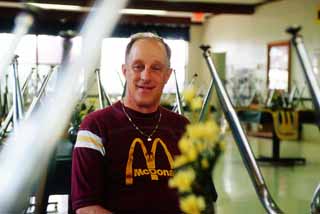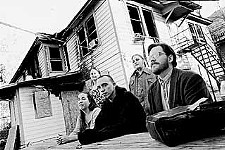Home on the Ranch
At Marbridge Ranch Assisted Living Facility, Life's Simple Pleasures Are the Best
By Stuart Prestidge, Fri., April 20, 2001

There are precious few places where, in one afternoon, one can learn the intricacies of 10-pin bowling, meet bona fide Olympians, and become the most interesting person on earth. One such place, however, is Marbridge Ranch, a 300-acre residential community located in South Austin -- home to 220 cognitively challenged individuals -- which has for the past 48 years quietly pursued its mission to enable each and every resident to fulfill his or her potential.
Like most people, my experiences with those living with cognitive challenges is woefully inept, having known just one gentleman some years ago who was born with Down Syndrome, a trend which belies the fact that 100,000 infants each year are born with some form of mental retardation. So as I drove through the picturesque winding roads of Manchaca on the way to Marbridge, my expectations revolved around some sort of strange variation of Dr. Moreau's island, complete with anonymous scientists in white coats plotting unknown evil, and the sterile, austere decor of cold steel and stark white tiles befitting any Hollywood asylum. It is exactly this kind of unfounded nonsense that is indicative of the prejudices that both those caring for and those living with mental retardation have to face every day, these prejudices being born from either fear, ignorance, or misinformation disseminated via mass media. What I found instead, however, was a marvelous facility, providing a vast array of recourses catering to the most severely handicapped, to those who need little more than modest supervision, and an environment in which they are encouraged to prosper.
Notwithstanding the tremendous facilities and location of Marbridge, the real highlight of the place is the residents themselves. I visited the area of Marbridge known as Mabee Village, which is home to approximately 70 residents of vastly differing ages and backgrounds and perhaps the most friendly and affable people you are ever likely to meet. The atmosphere was a relaxed mixture of retirement home and summer camp with many residents relaxing on open patios watching the world and this stranger go by.
What do the residents think of the facilities and how does it compare to their previous living experiences, I wondered as I sidled up to Joe Gillum, a resident of 10 years, to glean some answers. Joe, who works in the Mabee cafeteria washing dishes, as he has done since he arrived, said his favorite thing was "to go to the store and buy stuff." Asked what he did in his spare time, Joe paused for a minute then confidently replied that, despite the many activities offered, he "likes to sit around and listen to the radio and stuff."
Jay Simmons, a Marbridge resident for six years, who by day sacks groceries at Randalls, said Marbridge was "okay" but perked up considerably when the topic of recreational activities was raised. Jay, along with roughly 100 other residents of Marbridge, is a frequent competitor in the Special Olympics program, the world's largest program of year-round sports training and competition for persons with mental retardation and not to be confused with the Para-Olympics held shortly after the four-yearly Olympic games.
The Special Olympics holds 184 events annually within Texas in sports as varied as soccer, softball, and a veritable favorite, 10-pin bowling, at area, regional, or state levels. There is also a Special World Games staged during non-Olympic years. This past March saw 2,500 Special Olympians from around the world headed to Anchorage, Alaska, for the winter games, and 7,000 global competitors will head off to Ireland in 2003 for the summer games.
"I like bowling and running," Jay said. "At the same time?" I asked. His reply was a brief snigger followed by a hand movement that, as clear as any words, told me I had asked a stupid question. Jay then proceeded to take me into his home to show me the four trophies he had won at bowling at the annual State Special Olympics, although one had been given to him by a friend so, as Jay conceded, it "doesn't really count."
The brick condo-style edifice, which Jay calls home with three others, is a spacious affair. The large bedroom is divided into four semi-private zones, and the living room houses every conceivable seating device known to man and the largest entertainment center I had ever seen. Given the glorious surroundings, friendly neighbors, and pleasant living arrangements, I started to wonder if they had any spaces available and how much rent would be.
Not to be outdone by Jay's tales of bowling prowess, longtime roommate and fellow bowling ace Thomas Grisham quickly showed me his three bowling medals and more importantly, his two plaques of recognition awarded for outstanding work in his capacity as "Chief Janitor Executive Custodian Engineer," a position Thomas has proudly held for 22 years. With another year of service, Thomas hopes to be rewarded with an engraved nameplate for his office desk. (One assumes his employer is dreading the day Thomas, quite rightly, asks for a engraved plate bearing his job title, the cost of which will be simply horrendous.) Bowling, however, is not for everyone. While these folks were content to sit and chew the cud about bowling, others were taking a more hands-on approach to recreational time.
The Mabee gymnasium, situated roughly 100 yards from the residents' semi-circularly arranged homes, was alive with action as the Marbridge basketball team prepared for the upcoming regional Special Olympics. I spoke to the "B" team center Brad Roark who, far from being a nine-foot monstrous freak ô la Shaquille O'Neal, was a rather diminutive and shy young man who had to miss practice as he was waiting to go to work as dishwasher prep at a local restaurant. Brad claimed to be "excited" about the upcoming tournament and thought they would "do well." Brad's co-worker Robert Butler, who was awaiting the same transportation to get to work, and according to some Marbridge employees, can cook "the most delicious cookies," added that he could get me as many roses as I wanted, an offer not received every day and a great plus for any of Robert's girlfriends.
In addition to Mabee Village, Marbridge houses two other distinct areas that cater to those with progressively more apparent disabilities. The Villa, Marbridge's on-site nursing home, cares for roughly a third of the residents, but of the 175 full-time staff, employs roughly half. The staff includes direct care personnel and an array of licensed and qualified caregivers all with strange letters after their names. The second area is indeed named the Ranch for obvious reasons. The 70 or so residents here live in dormitory style rooms and most are employed. Due to the nature of their disabilities, the "ranchers" benefit from having a structured routine for daily chores and often respond well to educational programs that range from the three "R"s, to more specialized courses in money management, personal hygiene, and social skills training -- all approved by the Texas Rehabilitation Commission. All of the employed Ranch residents, therefore, work on-site, either in the facility's kitchen, at the Garden Center, which sells both produce and plants year round to the general public, or the Ranch, proper, tending to the many animals donated over the years.
Among the weird and wonderful animals that call Marbridge home are numerous cats, longhorns, miniature donkeys, rabbits, antelope, and two llamas, one of which is called Nicotine by virtue of his incessant spitting and whose rehabilitative worth is still under review. Ranchers who respond well to the individualized programs may be rewarded with a move to Mabee Village, the most unrestricted area of Marbridge. Aside from more freedom that Mabee allows, there are other benefits to this area of campus; "I have more friends, and I'm trying to apply for a job [off-site]" said Missy Rosem, a resident of five years who recently transferred from the Ranch. Asked what she missed about the Ranch, she replied, "my boyfriend." "Can't you visit him?" I inquired. "Oooh, I don't think I'm allowed to do that," she replied.
On the way out of the village I learned that, although fast, a motorbike is not the ideal vehicle for a quick getaway from Mabee. Not 10 feet from my parking space, I was surrounded and had to answer every conceivable question one could ask about motorbikes. This time was not wasted, however, as I learned from a man called Teddy how I could have made such a machine at home using the back wheel of another bike and lots of imagination, a revelation he seemed generally excited about, and why not?
A healthy and beneficial environment like Marbridge, however, does not come cheap. Monthly tuition is roughly $2,000 for both the Ranch and Mabee Village, rising up to $3,500 for semi-private accommodation in the Villa. Add into this equation that the average stay at Mabee Village is eight years, the Ranch 18 years, and the Villa 10 years, and the financial burden for those families caring for a mentally handicapped relative can be enormous. The options for those families are, however, limited. After graduating or completing school, the only option outside of private organizations like Marbridge are state-run institutions. These, in Texas at least, provide the best care they can with limited funds. Texas ranks 48th in the United States for the amount of spending that it provides for the continued care of the mentally challenged after graduation. Institutions still suffer from continued stigma, however, despite coming a long way from the old days of electric shock treatment and lobotomies. Yet, to much of the general public, One Flew Over the Cuckoo's Nest still serves as an uncomfortable paradigm. And, unfortunately, those impressions factor into funding issues. With a much-needed influx of federal money being an unlikely event, it is up to private organizations to take the initiative. The future, therefore, for Marbridge is simple, according to the Director of Advancement Donald Summers: "Fundraising, fundraising, fundraising."
Roughly two-thirds of the slots at Marbridge are paid for by federal government monies via Medicaid, a program that barely covers basic expenses and costs the ranch somewhere in the region of $500,000 per year in makeup spending. This has been recouped via word-of-mouth publicity and private donations, but the time has come to make a concerted effort to get the name out there and raise some serious cash, the main objectives being the expansion of the site (of 300 acres, only 50 are currently used), the upgrade of the buildings, and the ability to fund the living expenses of both current residents who simply run out of money or to award "scholarships" to those who would thrive in Marbridge's stimulating environment.
For now, however, Marbridge and its residents are content with a little recognition, satisfied to sit around quietly going about the business of building a community, fulfilling their vast potentials, and ... oh yes, taking in the occasional game of bowling. ![]()
The next Regional Track and Field Special Olympics meet, is Friday & Saturday, April 27-28, at Connolly High School, in Pflugerville, Texas. 835-9873.
For information regarding volunteering or donations, contact: Marbridge, PO Box 2250, Manchaca, TX, 78652, 282-1144 or www.marbridge.org







